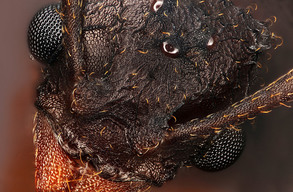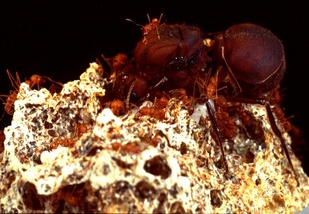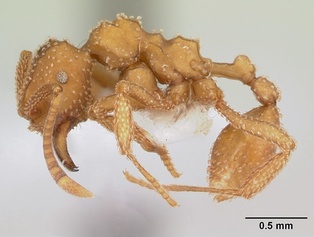The Evolution of Fungus Farming Ants, and How They Partnered with Microbes for Crop Protection  Fungus-farming ants stand as a testament to the overlooked marvels of the insect world, likely one of the reason’s why Dr. Jeffrey Sosa has dedicated the better part of his time as a researcher to elucidating the hidden intricacies of their biology. Having discovered over 30 species so far over the course of his career, few researchers can say with such confidence that we’ve only scratched the surface when it comes to understanding this enthralling tribe of insects. Agriculture as defined by Dr. Sosa, is the deliberate planting of the precursors of food products in substrate provided by the environment such as soil or mineral beds while also improving the growing conditions to maximize growth of the harvestable food product. Often associated with humans, there are actually at least 3 other organisms, all of which are insects, that exhibit this behavior. The most advanced example of insect farming are the fungus-farming ants, which are part of the tribe Attini and are restricted to the New World. Unlike humans, these diminutive farmers seem to have developed agriculture at one point in history: around the time mammals were establishing on the planet. Though Leaf-cutter ants are the most well-known of these insects, they only make-up about 20% of the described fungus-farming species.  The ecological interplay between the ants and their agricultural “crop” is even more complicated than it seems at first glance. The ants use living or dead biomass as a substrate for the growth of their fungi making sure to tend to matters of humidity, temperature, and even providing fertilizer to ensure optimal growth. The greatest threat to colony survival arises from a competitive fungus that feeds on and kills the cultivated fungal gardens. This fungus, in the genus Escovopsis, is unpalatable to ants and has the potential to lead to the death of an entire colony (Schultz et al. 2015). Fortunately the ants carry with them an actinomycete bacterium with anti-fungal properties that keeps the unintended fungus at bay. This bacterium has fine-tuned itself as a natural symbiotic pesticide for the ant crops over millions of years. The bacterium is so effective the fungus often only consumes the valuable crops within the colonies if the numbers of workers are reduced or the queen has died. Dr. Sosa further explained that there is a fourth mysterious player in this complex symbiosis: a black yeast that attacks the actinomycete bacterium (Sosa-Calvo and Schultz 2010). In a perplexing turn of events, Dr. Sosa and his colleagues have found that this yeast is intentionally cultivated in some Attine ants for reasons that still elude researchers; a question Dr. Sosa is anxious to answer in further studies. A good deal of Dr. Sosa’s research requires him to excavate entire ant colonies as he attempts to discover new species and better understand the connections between described species. When not digging pits in South American rainforests, Dr. Sosa has used a good deal of his time to analyze thousands of specimens from several collections to determine their systematic ranking within genera, a taxonomic grouping used to classify organisms, that periodically lack dichotomous keys or published references for identification. He’s described 37 new species, synonymized 4 species, and even revived a species from synonymy (Sosa-Calvo et al. 2006, Azorsa and Sosa-calvo 2008, Bolton et al. 2008). In his time studying the mysterious genus Myrmicocrypta, he’s been able to lend credence to its stability as a monophyletic group by analyzing DNA sequences of nuclear genes from the ants (Sosa-Calvo et al. 2013).  Dr. Sosa’s research has yielded surprising results at times. Many were surprised at the publication of his research titled: “The most relictual fungus-farming ant species cultivates the most recently evolved and most highly domesticated fungal symbiont species”. As it turns out, Apterostigma megacephala, a species that is among the most primitive fungus-farming ants, farms the fungus that has seen the greatest amount of evolutionary change. Indeed this fungus species has evolved to an extent that it can’t survive without it’s ant cultivators (Schultz et al. 2015). One analogy that has been used for this situation is Neanderthals cultivating GMO corn. With all the questions raised by these discoveries, Dr. Sosa intends to focus his research for the immediate future on building a phylogeny (determining evolutionary relationships) of these fungi as a means to further understand the ants that have evolved in intimate association with them for millions upon millions of years. When two species are as closely connected as these the evolutionary relationships they have with each other can be strongly influenced by each other’s presence. With further study the traces of these influences on each other’s evolutionary past can be deciphered. I think I can speak for all of my colleagues when I say we’re certainly looking forward to seeing what further insights Dr. Sosa’s studies will provide. References: Azorsa, F., and J. Sosa-Calvo. 2008. Description of a remarkable new species of ant in the genus. Zootaxa. 38: 27–38. Bolton, B., J. Sosa-Calvo, F. Fernandez, and J. E. Lattke. 2008. New synonyms in neotropical Myrmicine ants (Hymenoptera: Formicidae). Zootaxa. 64: 61–64. Schultz, T. R., J. Sosa-Calvo, S. G. Brady, C. T. Lopes, U. G. Mueller, M. Bacci, and H. L. Vasconcelos. 2015. The Most Relictual Fungus-Farming Ant Species Cultivates the Most Recently Evolved and Highly Domesticated Fungal Symbiont Species. Am. Nat. 000–000. Sosa-Calvo, J., and T. R. Schultz. 2010. Three Remarkable New Fungus-Growing Ant Species of the Genus Myrmicocrypta (Hymenoptera: Formicidae), with a Reassessment of the Characters That Define the Genus and Its Position within the Attini. Ann. Entomol. Soc. Am. 103: 181–195. Sosa-Calvo, J., T. R. Schultz, C. R. F. Brandão, C. Klingenberg, R. M. Feitosa, C. Rabeling, M. Bacci, C. T. Lopes, and H. L. Vasconcelos. 2013. Cyatta abscondita: Taxonomy, evolution, and natural history of a new fungus-farming ant genus from Brazil. PLoS One. 8: 1–20. Sosa-Calvo, J., S. O. Shattuck, and T. R. Schultz. 2006. Dacetine ants of Panama: new records and description of a new species (Hymenoptera: Formicidae: Myrmicinae: Dacetini). Proc. Entomol. Soc. Washingt. 108: 814–821. Image Sources: Flickr Creative Commons, Wikimedia Creative Commons About the Authors:
Armando Rosario-Lebron is a graduate student in the laboratory of Dr. Cerruti RR Hooks. His work focuses on improving Maryland agriculture through diversification of farmland by harnessing natural enemies through increased habitat diversity. Part of his work focuses on how cover crops and flowering plants can be introduced as methods to increase habitat diversity in Maryland Agriculture. Samuel Ramsey is a 3rd year PhD student in Dennis vanEngelsdorp’s bee lab currently studying the biology of and control measures for the invasive varroa mite, a parasite implicated in sizeable colony loss globally. Comments are closed.
|
Categories
All
Archives
June 2024
|
Department of Entomology
University of Maryland
4112 Plant Sciences Building
College Park, MD 20742-4454
USA
Telephone: 301.405.3911
Fax: 301.314.9290
University of Maryland
4112 Plant Sciences Building
College Park, MD 20742-4454
USA
Telephone: 301.405.3911
Fax: 301.314.9290

 RSS Feed
RSS Feed




